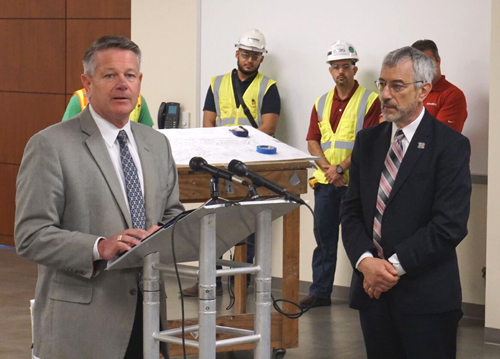Despite the efforts of Houston and Texas construction leaders to bolster the workforce in a variety of ways, a staggering 78 percent of contractors in this state still say they are struggling to find qualified craft workers needed to keep up with demand.
That’s why the AGC of America this week in Houston unveiled a new workforce plan including a renewed call for immigration reform at the national level.
“As demand for construction grows, contractors need more trained workers than are currently available,” said Ken Simonson, chief economist for the Associated General Contractors. The group announced the results of their new survey during a tour of MAREK Construction, a large specialty subcontractor.
“This year we asked about 20 specific crafts, and for all but one of those it was harder to fill those positions than it was last year,” Simonson said. “The best way to enable further economic growth, facilitate rebuilding aging infrastructure and get more people into high-paying construction careers is to address industry workforce shortages,” Simonson said. Nowhere in the country is it more important to address critical infrastructure than in Houston one year after the devastation wrought by Hurricane Harvey, Simonson said.
He was joined during a morning news conference on Wednesday by MAREK COO Mike Holland along with Dan Gilbane, Sr. Vice President of the Southwest Division of Gilbane Building Company and others.
“This is a complex problem and has been deteriorating for years,” Holland said, adding that business leaders have been working diligently to address the shortfall. The Construction Career Collaborative, or C3, and the Greater Houston Partnership’s Upskill program have made great strides in recent years, but there is much more to do.
“Upskill is identifying dynamic solutions,” Holland said. “Collaboration is key.”
“We have to treat workforce development as an investment,” said Gilbane, who also serves as chair of the Upskill executive committee. He argued that it is up to industry to provide a clear career path so that current and future employees will be able envision what’s possible “based on the merits of their performance.”

“It’s important to acknowledge that many careers don’t require a four-year degree,” Gilbane said. “This is the very essence of Houston’s opportunity story and the American dream itself.”
Chuck Gremillion, executive director of C3, said the nonprofit is working with owners of projects to advance the financial security, health and well-being of the construction craft workforce, actively implement and support the best construction safety practices, and commit to the development and delivery of continuous skills training linked to construction career paths for the craft workforce.
 Simonson said many companies are also using innovative new technologies that he called “cool tools” to handle the workload with fewer people. Twenty-six percent of Texas firms are adopting methods like offsite prefabrication, lean construction and building information modeling – or BIM – to make their operations more efficient. “An equal share report they are increasing their use of labor saving-equipment and technology to be able to do more work with fewer people,” Simonson said.
Simonson said many companies are also using innovative new technologies that he called “cool tools” to handle the workload with fewer people. Twenty-six percent of Texas firms are adopting methods like offsite prefabrication, lean construction and building information modeling – or BIM – to make their operations more efficient. “An equal share report they are increasing their use of labor saving-equipment and technology to be able to do more work with fewer people,” Simonson said.
Despite that, the worker shortage is causing construction costs to rise and putting many projects behind schedule.
“Fifty-two percent of Texas firms report that workforce shortages have prompted them to put higher prices into their bids,” the AGC said. “And 45 percent report that already-underway projects cost more than first anticipated. At the same time, 44 percent of Texas firms report that labor shortages are causing projects to take longer than originally scheduled and 26 percent report they have put longer completion times into their bids.”
The AGC’s Workforce Development Plan calls on congress to double the funding for career and technical education over the next five years and pass legislation to allow more people with construction skills to legally enter the country.
“It would not open the floodgates, as they say,” Simonson said. “But it would make sure that people are allowed in if there’s a job that exists for them.”
Industry leaders like Holland and his CEO Stan Marek have long said that undocumented immigrants should be identified and be required to work for employers that deduct and match taxes. The Houston area alone is home to 600,000 undocumented people, many of whom are already participating in the labor force.
“We can’t begin the solution with subtraction,” Holland said. “We cannot begin to carve out progress by rejecting a significant portion of our workforce.”
You can read the entire Workforce Development Plan here. The AGC’s Texas Survey results are here. National results are here.


